Astronomers Discover Exact Mass Needed for Star Formation

Brown dwarf binaries observed during this study, each orbiting around their center of mass (marked by an x). Credit: Trent Dupuy, Karen Teramura, PS1SC.
New research using Hawai‘i Island’s most powerful telescopes on Maunakea has revealed the threshold at which stars either successfully form or fail.
“When we look up and see the stars shining at night, we are seeing only part of the story,” said Trent Dupuy of the University of Texas at Austin and a graduate of the Institute for Astronomy at UH Mānoa. “Not everything that could be a star ‘makes it,’ and figuring out why this process sometimes fails is just as important as understanding when it succeeds.”
Dupuy is the lead author of the study which was conducted using data from the W.M. Keck Observatories and Canada-France-Hawa‘ii Telescope, as well as the Hubble Space Telescope.
Stars are born when a cloud of gas and dust collapses under the force of gravity, resulting in a ball of matter that becomes hot and dense enough to sustain nuclear reactions at its core. The reactions create huge amounts of energy, emitting the brilliant light that make stars shine. Our own Sun’s nuclear reactions create the energy and subsequent light that make most life on Earth possible.
But not all stars successfully undergo this process. Some collapse into a ball that isn’t quite dense enough to create nuclear fusion. These ‘failed stars’ are called brown dwarfs.
Scientists have recognized the difference between stars and brown dwarfs for decades, and have theorized the amount of mass it takes to successfully create a star for over 50 years. However, no experiment has ever confirmed the exact mass. Until now.
Astronomers Dupuy and University of Hawai‘i’s Michael Liu, co-author of the study, have determined that an object must weigh the equivalent of 70 Jupiters in order to create nuclear fusion and become a star. Any less than that and nuclear reactions do not ignite, resulting in a brown dwarf. The conclusion is a somewhat lower number than predictions.
How did they reach this conclusion? For 10 years, the duo studied 31 brown dwarf binaries (pairs that orbit one another) using the W.M. Keck Observatory and Canada-France-Hawai‘i Telescope, as well as data from the Hubble Space Telescope.
By collecting and analyzing imagery of these binaries over several years, Dupuy and Liu were able to conclude their mass by measuring the brown dwarfs’ size and speed as they orbited a shared center of mass (an invisible point where the pull of gravity between the pair is equal).
The study required the use of the world’s most powerful telescopes because brown dwarfs emit much less light than stars, and move much more slowly in orbit. After a decade of observations, the study has provided the first large sample of brown dwarf masses.
“As they say, good things come to those who wait,” said Liu. “While we’ve had many interesting brown dwarf results over the past 10 years, this large sample of masses is the big payoff. These measurements will be fundamental to understanding both brown dwarfs and stars for a very long time.”
The resulting data has not only revealed the mass that makes the difference between a star and brown dwarf, but also the surface temperature. Any object cooler than 1,600 Kelvin (about 2,400 degrees Fahrenheit) is not a star, but a brown dwarf.
The study will help astronomers understand the conditions under which stars form and evolve, or sometimes fail. The conclusions also indicate how, where and why solar systems are created.
Dupuy and Liu’s research will be published in the next issue of The Astrophysical Journal Supplement. A preprint can be found online.
The following animation shows several of the brown dwarf binaries observed during the study, each orbiting around its center of mass, which is marked by an x. Colors indicate surface temperatures, from warmest to coolest: gold, red, magenta, or blue. The background image is a map of the entire sky visible from Hawaiʻi and a silhouette of Maunakea, home to Keck Observatory and the Canada-France-Hawaiʻi Telescope where this study was conducted over the past decade. Each binary is shown roughly where it is located on the night sky. The actual sizes of these orbits on the sky are very small (about one billionth the area covered by an “x”), but the orbit sizes shown in the animation are accurate relative to each other. The animation is also in extreme fast-forward, where every one second in the animation corresponds to approximately 2 years of real time. Credit: Trent Dupuy, Karen Teramura, PS1SC













